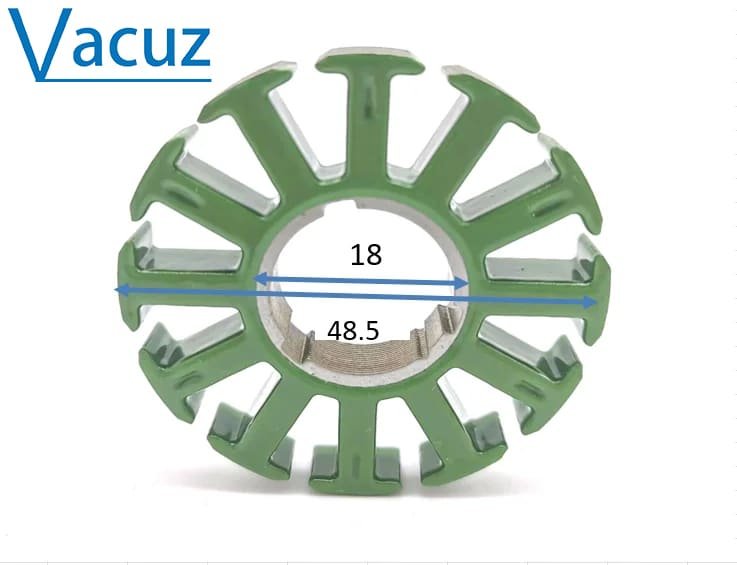The accuracy of the fully automatic motor stator winding machine is affected by many factors. In order to improve its accuracy, we must conduct comprehensive optimization from multiple aspects such as mechanics, electrical, materials, environment and management. The following is a detailed analysis by Vacuz:

Персонализиране на висококачествен дрон RC UAV BLDC моторно ядро Ламиниране на вентилатор Безчетков статор Ламиниран електрически дрон моторно статорно ядро
I. Multiple factors affecting winding accuracy
1. Mechanical structure level
(1) Transmission system: the accuracy of the lead screw and synchronous belt, the straightness of the guide rail and the radial runout of the rotary table.
(2) Tension mechanism: the elastic deformation of the tension arm and the coaxiality of the wire wheel will affect the fluctuation of the tension.
(3) Fixture design: the concentricity of the stator clamping and the wear of the positioning pin. Wear will cause the slot to shift.
2. Control system level
(1) Servo performance: the response frequency of the driver (must reach or exceed 1kHz), the resolution of the encoder (for example, a 20-bit absolute encoder).
(2) Control algorithm: interpolation algorithm (such as S-shaped acceleration and deceleration control) and tension closed-loop PID parameters (overshoot must be less than 3%).
(3) Software logic: winding mode (step or continuous) and wire diameter compensation algorithm (can automatically correct the tolerance of enameled wire).
3. Material property level
(1) Enameled wire: uniformity of wire diameter (CV value must be less than or equal to 0.003) and toughness of insulation layer (must be able to avoid cracking caused by excessive tension).
(2) Stator slot type: slot size tolerance (±0.02 mm) and whether there are burrs in the slot (burrs may scratch the enameled wire).
4. Environmental factors level
(1) Vibration: ground vibration must be controlled (must be less than or equal to 0.5 mm/s) or interference from adjacent equipment.
(2) Temperature: If the temperature difference in the workshop exceeds 5°C, it may cause mechanical deformation.
(3) Humidity: High humidity (more than 60%RH) may cause static electricity or cause the enameled wire to become damp.
5. Human operation level
(1) Parameter settings may be incorrect (such as tension value, winding speed, etc.).
(2) Maintenance may be insufficient (e.g., dust accumulated on the winding nozzle is not cleaned regularly).
2. Strategies to improve precision and quality
1. Mechanical optimization
(1) Upgrade key components: Use air-floating spindles, ceramic wire wheels, etc. to reduce wear.
(2) Regular calibration: Use laser interferometer to check the screw accuracy every month and check the concentricity of the rotary table every quarter.
(3) Vibration reduction design: Add a base or active vibration reduction table to reduce the impact of vibration.
2. Control strategy upgrade
(1) Closed-loop tension control: Add tension sensors (such as strain gauges) and feedback algorithms to achieve more accurate tension control.
(2) Dynamic compensation: Use a visual system (such as the Keyence CV-X series) to detect the slot position in real time and correct the path.
(3) Intelligent parameter adjustment: Introduce AI algorithms (such as neural networks) to automatically optimize tension and speed parameters.
3. Material and process control
(1) Incoming material inspection: Use a laser diameter gauge (with an accuracy of ±0.5 microns) to screen enameled wire.
(2) Stator pretreatment: Use deburring tooling, vacuum encapsulation to fix the coil and other processes to prevent looseness.
(3) Environmental control: Establish a constant temperature and humidity workshop (temperature controlled at 25±2℃/humidity controlled at 50±5%RH).
4. Detection and feedback system
(1) Online monitoring: Deploy six-dimensional force sensors to detect abnormal collisions during winding.
(2) Visual quality inspection: Use AOI equipment (such as Omron FZV3-300) to detect key indicators such as coil shape and number of turns.
(3) Data traceability: Record key parameters (such as tension, speed, temperature, etc.) through the MES system for traceability analysis.
5. Management optimization
(1) Standardized operation: Formulate SOP (such as mold change process, parameter adjustment specifications, etc.) to standardize the operation process.
(2) Skill training: Operators need to pass special certifications such as tension control and mechanical calibration to improve their skills.
(3) Preventive maintenance: Develop a PM plan (such as replacing the tension spring every 5,000 windings) to prevent equipment failure.
6. R&D laboratory: Configure modular winding heads to support fast switching of multiple wire types, and integrate vibration sensors to achieve more accurate dynamic compensation.

Vacuz Two Stations BLDC Brushless Drone Motor Stator Coil Flying Fork Winding Machine Delivery
In summary, winding accuracy is the comprehensive result of the interaction of multiple factors such as mechanical, electrical, material and environmental factors. I hope these little knowledge can help you!
Имейл: sales@vacuz.com





